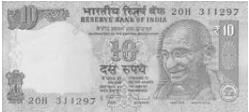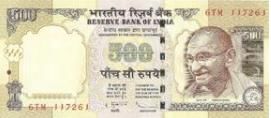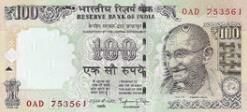All Exams >
Grade 1 >
Mathematics for Grade 1 >
All Questions
All questions of Money for Grade 1 Exam
Which note you will use to pay for the given item of worth Rs. 9?
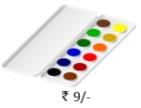
- a)Rs. 5 note
- b)Rs. 20 note
- c)Rs. 10 note
- d)None of these
Correct answer is option 'C'. Can you explain this answer?
Which note you will use to pay for the given item of worth Rs. 9?


a)
Rs. 5 note
b)
Rs. 20 note
c)
Rs. 10 note
d)
None of these
|
|
Pranav Singh answered |
A 10 rupee note will be used to water colours worth Rs. 9 to purchase.
Which set of coins shows Rs. 5?
- a)

- b)

- c)

- d)

Correct answer is option 'D'. Can you explain this answer?
Which set of coins shows Rs. 5?
a)

b)

c)

d)

|
|
Pranav Singh answered |
50p + 50p = Rs.1.
Rs.1 + Rs.1 + Rs.2 + Rs.1 = Rs.5.
Rs.1 + Rs.1 + Rs.2 + Rs.1 = Rs.5.
Which of the following will you use to buy a toy car of Rs. 50?- a) One note of Rs. 50.
- b) Four note of Rs. 10 and two Rs. 5 coins
- c) Two notes of Rs. 20.
- d) Both (a) and (b).
Correct answer is option 'D'. Can you explain this answer?
Which of the following will you use to buy a toy car of Rs. 50?
a)
One note of Rs. 50.
b)
Four note of Rs. 10 and two Rs. 5 coins
c)
Two notes of Rs. 20.
d)
Both (a) and (b).
|
|
Harsh mehra answered |
Answer:
To buy a toy car of Rs. 50, we can use either a single note of Rs. 50 or a combination of smaller denominations that add up to Rs. 50. Option (a) and (b) provide two such combinations.
(a) One note of Rs. 50:
This is the simplest and easiest way to buy the toy car. We just need to give the shopkeeper a single note of Rs. 50 and we will get the car. This method requires only one transaction and one piece of currency.
(b) Four notes of Rs. 10 and two Rs. 5 coins:
This is another way to buy the toy car. We can give the shopkeeper four notes of Rs. 10 and two coins of Rs. 5 each. This method requires five transactions (giving four notes and two coins) and six pieces of currency (four notes and two coins). However, it is still a valid way to buy the toy car.
Therefore, option (d) is the correct answer as it includes both options (a) and (b) as valid ways to buy the toy car of Rs. 50.
To buy a toy car of Rs. 50, we can use either a single note of Rs. 50 or a combination of smaller denominations that add up to Rs. 50. Option (a) and (b) provide two such combinations.
(a) One note of Rs. 50:
This is the simplest and easiest way to buy the toy car. We just need to give the shopkeeper a single note of Rs. 50 and we will get the car. This method requires only one transaction and one piece of currency.
(b) Four notes of Rs. 10 and two Rs. 5 coins:
This is another way to buy the toy car. We can give the shopkeeper four notes of Rs. 10 and two coins of Rs. 5 each. This method requires five transactions (giving four notes and two coins) and six pieces of currency (four notes and two coins). However, it is still a valid way to buy the toy car.
Therefore, option (d) is the correct answer as it includes both options (a) and (b) as valid ways to buy the toy car of Rs. 50.
Mohan has four Rs. 5 coins, out of which he gave 3 Rs. 5 coins to buy a toy. How much money, he is left with?- a)Rs.2
- b)Rs.5
- c)Rs.10
- d)Rs.1
Correct answer is option 'B'. Can you explain this answer?
Mohan has four Rs. 5 coins, out of which he gave 3 Rs. 5 coins to buy a toy. How much money, he is left with?
a)
Rs.2
b)
Rs.5
c)
Rs.10
d)
Rs.1
|
|
Pranav Singh answered |
4 Rs. 5 coins, =? 20. 3 coins of Rs. 5 = Rs. 15. 3 coins = 
He is left with

He is left with

Rahul has Rs. 20 in his Piggy Bank. He wants to purchase two pencils worth Rs. 6. One candy of Rs. 1 and two chocolates of Rs. 10. How much money will be left in his Piggy Bank after purchasing these items?
- a)Rs.5
- b)Rs.4
- c)Rs.3
- d)Rs.2
Correct answer is option 'C'. Can you explain this answer?
Rahul has Rs. 20 in his Piggy Bank. He wants to purchase two pencils worth Rs. 6. One candy of Rs. 1 and two chocolates of Rs. 10. How much money will be left in his Piggy Bank after purchasing these items?
a)
Rs.5
b)
Rs.4
c)
Rs.3
d)
Rs.2
|
|
Swati Sharma answered |
Price of two pencils, one candy and two chocolate will be Rs. (6 + 1 + 10) = Rs.17. So, remaining amount in Piggy Bank = Rs. (20 - 17) = Rs.3.
What is the total of following notes? 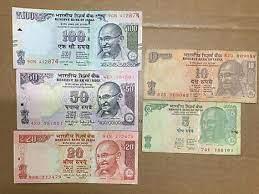
- a) Rs. 180
- b) Rs. 157
- c) Rs. 185
- d) Rs. 175
Correct answer is option 'C'. Can you explain this answer?
What is the total of following notes?
a)
Rs. 180
b)
Rs. 157
c)
Rs. 185
d)
Rs. 175
|
|
Naina Sharma answered |
The total amount of these notes are Rs. 100 + Rs. 50 + Rs. 20 + Rs. 10 + Rs. 5 = Rs.185.
Money is counted in terms of notes and _________ .- a)value
- b)rupees
- c)coins
- d)Paise
Correct answer is option 'C'. Can you explain this answer?
Money is counted in terms of notes and _________ .
a)
value
b)
rupees
c)
coins
d)
Paise
|
|
Muskaan reddy answered |
Counting Money in Terms of Coins
Introduction:
In India, money is counted in terms of notes and coins. While notes are used for larger denominations, coins are used for smaller denominations.
Coins:
Coins are small, round, and metallic objects that are issued by the government as a form of currency. They come in different shapes, sizes, and denominations.
Denominations:
Coins are issued in denominations of 50 paise, 1 rupee, 2 rupees, 5 rupees, and 10 rupees. The 50 paise coin is no longer in circulation and has been replaced by the 1 rupee coin.
Value:
The value of coins is determined by their denominations. For example, a 1 rupee coin has a value of 1 rupee, a 2 rupee coin has a value of 2 rupees, and so on.
Counting:
When counting coins, it is important to sort them by their denominations first. Then, they can be counted by grouping them in piles of ten. For example, ten 1 rupee coins make a pile of 10 rupees.
Conclusion:
In conclusion, coins are an important part of the Indian currency system and are used for smaller denominations. They are counted by sorting them by their denominations and grouping them in piles of ten.
Introduction:
In India, money is counted in terms of notes and coins. While notes are used for larger denominations, coins are used for smaller denominations.
Coins:
Coins are small, round, and metallic objects that are issued by the government as a form of currency. They come in different shapes, sizes, and denominations.
Denominations:
Coins are issued in denominations of 50 paise, 1 rupee, 2 rupees, 5 rupees, and 10 rupees. The 50 paise coin is no longer in circulation and has been replaced by the 1 rupee coin.
Value:
The value of coins is determined by their denominations. For example, a 1 rupee coin has a value of 1 rupee, a 2 rupee coin has a value of 2 rupees, and so on.
Counting:
When counting coins, it is important to sort them by their denominations first. Then, they can be counted by grouping them in piles of ten. For example, ten 1 rupee coins make a pile of 10 rupees.
Conclusion:
In conclusion, coins are an important part of the Indian currency system and are used for smaller denominations. They are counted by sorting them by their denominations and grouping them in piles of ten.
How many 50 paise coins make Rs. 5?- a)8
- b)5
- c)10
- d)4
Correct answer is option 'C'. Can you explain this answer?
How many 50 paise coins make Rs. 5?
a)
8
b)
5
c)
10
d)
4
|
|
Sandhya sharma answered |
Understanding the Problem
To determine how many 50 paise coins are needed to make Rs. 5, we first need to understand the relationship between paise and rupees.
Conversion of Rupees to Paise
- 1 Rupee = 100 Paise
- Therefore, Rs. 5 = 5 x 100 = 500 Paise
Value of Each Coin
- Each 50 paise coin is worth 50 Paise.
Calculating the Number of Coins
To find out how many 50 paise coins make up 500 paise, we use the following calculation:
- Total Paise Needed = 500 Paise
- Value of Each Coin = 50 Paise
Now, we divide the total paise by the value of each coin:
- Number of Coins = Total Paise / Value of Each Coin
- Number of Coins = 500 Paise / 50 Paise = 10
Conclusion
Thus, you need a total of 10 coins of 50 paise each to make Rs. 5.
The correct answer is option 'C', which signifies that 10 coins are required.
To determine how many 50 paise coins are needed to make Rs. 5, we first need to understand the relationship between paise and rupees.
Conversion of Rupees to Paise
- 1 Rupee = 100 Paise
- Therefore, Rs. 5 = 5 x 100 = 500 Paise
Value of Each Coin
- Each 50 paise coin is worth 50 Paise.
Calculating the Number of Coins
To find out how many 50 paise coins make up 500 paise, we use the following calculation:
- Total Paise Needed = 500 Paise
- Value of Each Coin = 50 Paise
Now, we divide the total paise by the value of each coin:
- Number of Coins = Total Paise / Value of Each Coin
- Number of Coins = 500 Paise / 50 Paise = 10
Conclusion
Thus, you need a total of 10 coins of 50 paise each to make Rs. 5.
The correct answer is option 'C', which signifies that 10 coins are required.
Which of the following you can buy from 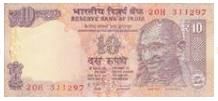 note?
note?- a)

- b)

- c)

- d)

Correct answer is option 'A'. Can you explain this answer?
Which of the following you can buy from  note?
note?
 note?
note?a)

b)

c)

d)

|
|
Pranav Singh answered |
Pencil which is of Rs. 5 can be bought from Rs. 10 note.
Mohan has four Rs. 5 coins, out of which he gave 3 Rs. 5 coins to buy a toy. How much money, he is left with?- a)Rs.2
- b)Rs.1
- c)Rs.10
- d)Rs.5
Correct answer is option 'D'. Can you explain this answer?
Mohan has four Rs. 5 coins, out of which he gave 3 Rs. 5 coins to buy a toy. How much money, he is left with?
a)
Rs.2
b)
Rs.1
c)
Rs.10
d)
Rs.5
|
|
Muskaan reddy answered |
Remaining Money Calculation:
Mohan initially had 4 Rs. 5 coins, and he gave 3 of them to buy a toy. To find out how much money he is left with, we need to subtract the amount he spent from the total amount he initially had.
Calculation:
Total amount initially = 4 Rs. 5 coins = 4 * Rs. 5 = Rs. 20
Amount spent = 3 Rs. 5 coins = 3 * Rs. 5 = Rs. 15
Remaining money = Total amount initially - Amount spent = Rs. 20 - Rs. 15 = Rs. 5
Answer Explanation:
Therefore, Mohan is left with Rs. 5 after giving away 3 Rs. 5 coins to buy a toy. Hence, the correct answer is option 'D' (Rs. 5).
Mohan initially had 4 Rs. 5 coins, and he gave 3 of them to buy a toy. To find out how much money he is left with, we need to subtract the amount he spent from the total amount he initially had.
Calculation:
Total amount initially = 4 Rs. 5 coins = 4 * Rs. 5 = Rs. 20
Amount spent = 3 Rs. 5 coins = 3 * Rs. 5 = Rs. 15
Remaining money = Total amount initially - Amount spent = Rs. 20 - Rs. 15 = Rs. 5
Answer Explanation:
Therefore, Mohan is left with Rs. 5 after giving away 3 Rs. 5 coins to buy a toy. Hence, the correct answer is option 'D' (Rs. 5).
Choose odd one out- a)Rs. 10
- b)Rs. 30
- c)Rs.100
- d)Rs.50
Correct answer is option 'B'. Can you explain this answer?
Choose odd one out
a)
Rs. 10
b)
Rs. 30
c)
Rs.100
d)
Rs.50
|
|
Harsh mehra answered |
Understanding the Options
In this question, we are given four monetary values: Rs. 10, Rs. 30, Rs. 100, and Rs. 50. Our task is to identify the odd one out, which in this case is option 'B' (Rs. 30).
Analysis of the Options
- Rs. 10: This is a basic denomination often used in daily transactions.
- Rs. 30: This amount is not a common denomination in Indian currency. It is typically not used as a standalone bill or coin in regular transactions.
- Rs. 100: This is a widely accepted and commonly used denomination in various transactions.
- Rs. 50: Similar to Rs. 100, this is also a common bill used frequently in commerce.
Why Rs. 30 is the Odd One Out
- Non-standard Denomination: Rs. 30 does not have a dedicated bill or coin in circulation. Instead, it is usually formed by combining smaller denominations like Rs. 10 and Rs. 20 or Rs. 50 minus Rs. 20.
- Practical Usage: While Rs. 10, Rs. 50, and Rs. 100 can be easily used and accepted in transactions, Rs. 30 is less practical and less frequently encountered.
Conclusion
Thus, when considering the commonality and practical usage of currency denominations, Rs. 30 stands out as the odd one out. This analysis highlights the importance of recognizing standard denominations in currency.
In this question, we are given four monetary values: Rs. 10, Rs. 30, Rs. 100, and Rs. 50. Our task is to identify the odd one out, which in this case is option 'B' (Rs. 30).
Analysis of the Options
- Rs. 10: This is a basic denomination often used in daily transactions.
- Rs. 30: This amount is not a common denomination in Indian currency. It is typically not used as a standalone bill or coin in regular transactions.
- Rs. 100: This is a widely accepted and commonly used denomination in various transactions.
- Rs. 50: Similar to Rs. 100, this is also a common bill used frequently in commerce.
Why Rs. 30 is the Odd One Out
- Non-standard Denomination: Rs. 30 does not have a dedicated bill or coin in circulation. Instead, it is usually formed by combining smaller denominations like Rs. 10 and Rs. 20 or Rs. 50 minus Rs. 20.
- Practical Usage: While Rs. 10, Rs. 50, and Rs. 100 can be easily used and accepted in transactions, Rs. 30 is less practical and less frequently encountered.
Conclusion
Thus, when considering the commonality and practical usage of currency denominations, Rs. 30 stands out as the odd one out. This analysis highlights the importance of recognizing standard denominations in currency.
Cost of three items are Rs. 7, Rs. 9 and Rs. 3 respectively. Find the total cost of 3 items?- a) Rs.19
- b) Rs.12
- c) Rs.11
- d) Rs.15
Correct answer is option 'A'. Can you explain this answer?
Cost of three items are Rs. 7, Rs. 9 and Rs. 3 respectively. Find the total cost of 3 items?
a)
Rs.19
b)
Rs.12
c)
Rs.11
d)
Rs.15
|
|
Pranav Singh answered |
Rs.7 + Rs.9 = Rs.16 Rs.16 + Rs.3 = Rs.19.
Identify the total value of the following combination of money? 50p, Rs.2, Rs.10, Rs.5, 50p, 50p- a) Rs.15, 50p
- b)Rs.17, 50p
- c) Rs.16, 50p
- d)Rs.18, 50p
Correct answer is option 'D'. Can you explain this answer?
Identify the total value of the following combination of money? 50p, Rs.2, Rs.10, Rs.5, 50p, 50p
a)
Rs.15, 50p
b)
Rs.17, 50p
c)
Rs.16, 50p
d)
Rs.18, 50p
|
|
Rahul Desai answered |
Total value of the combination of money is Rs. 18. 50 p.
 can be taken from?
can be taken from?- a)

- b)

- c)

- d)

Correct answer is option 'A'. Can you explain this answer?
 can be taken from?
can be taken from?a)

b)

c)

d)

|
|
Pranav Singh answered |
Four 50p coins makes Rs. 2.
Deepak purchased a T-shirt worth rupees four hundred. Which of the following represents this amount?- a)Rs.100
- b)Rs.200
- c)Rs.300
- d)Rs.400
Correct answer is option 'D'. Can you explain this answer?
Deepak purchased a T-shirt worth rupees four hundred. Which of the following represents this amount?
a)
Rs.100
b)
Rs.200
c)
Rs.300
d)
Rs.400
|
|
Swati Sharma answered |
He will pay Rs.400 for buying the T-Shirt.
How much cheaper is the handkerchief than the ice-cream?
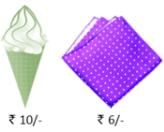
- a)Rs.2
- b)Rs.3
- c)Rs.4
- d)Rs.5
Correct answer is option 'C'. Can you explain this answer?
How much cheaper is the handkerchief than the ice-cream?


a)
Rs.2
b)
Rs.3
c)
Rs.4
d)
Rs.5
|
|
Neha Verma answered |
Ice-cream costs Rs. 10 and handkerchief costs Rs. 6. So handkerchief is Rs. 4 cheaper than the ice-cream.
Study the given information and answer the following questions. Bala put Rs. 1 into his Piggy Bank on the first day. He put Rs. 2 on the second day, Rs. 3 on the third and Rs. 4 on fourth day. How much money does Bala have in his Piggy Bank after 4 days?- a)Rs.6
- b)Rs.10
- c)Rs. 18
- d)Rs. 21
Correct answer is option 'B'. Can you explain this answer?
Study the given information and answer the following questions. Bala put Rs. 1 into his Piggy Bank on the first day. He put Rs. 2 on the second day, Rs. 3 on the third and Rs. 4 on fourth day. How much money does Bala have in his Piggy Bank after 4 days?
a)
Rs.6
b)
Rs.10
c)
Rs. 18
d)
Rs. 21
|
|
Pranav Singh answered |
Rs. (1+2+3+4)= Rs.10.
Chapter doubts & questions for Money - Mathematics for Grade 1 2025 is part of Grade 1 exam preparation. The chapters have been prepared according to the Grade 1 exam syllabus. The Chapter doubts & questions, notes, tests & MCQs are made for Grade 1 2025 Exam. Find important definitions, questions, notes, meanings, examples, exercises, MCQs and online tests here.
Chapter doubts & questions of Money - Mathematics for Grade 1 in English & Hindi are available as part of Grade 1 exam.
Download more important topics, notes, lectures and mock test series for Grade 1 Exam by signing up for free.
Mathematics for Grade 1
7 videos|77 docs|21 tests
|

Contact Support
Our team is online on weekdays between 10 AM - 7 PM
Typical reply within 3 hours
|
Free Exam Preparation
at your Fingertips!
Access Free Study Material - Test Series, Structured Courses, Free Videos & Study Notes and Prepare for Your Exam With Ease

 Join the 10M+ students on EduRev
Join the 10M+ students on EduRev
|

|
Create your account for free
OR
Forgot Password
OR
Signup to see your scores
go up within 7 days!
Access 1000+ FREE Docs, Videos and Tests
Takes less than 10 seconds to signup

